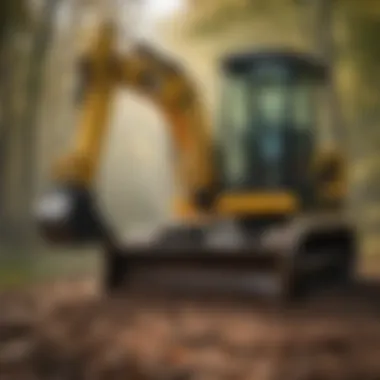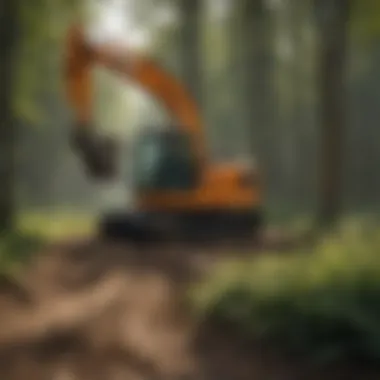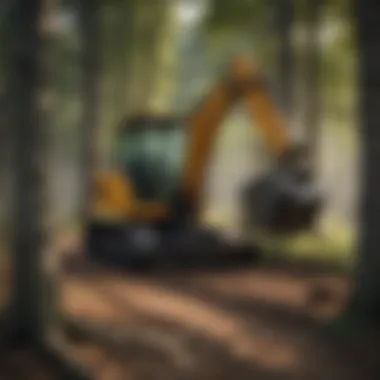Exploring Excavator Mulchers: Uses, Advantages, and Care


Intro
Excavator mulchers serve a critical role in modern forestry and land management. As machinery designed to efficiently mulch vegetation, they offer numerous advantages in clearing land and managing woodlands. Their unique ability to process various organic materials into mulch helps promote soil health, reduces erosion, and supports biodiversity. This article will explore the functionality, benefits, and best practices of excavator mulchers, providing a comprehensive understanding for forestry professionals and academics alike.
Forest Ecology and Biodiversity
Importance of Forest Ecosystems
Forests are not merely collections of trees; they are complex ecosystems that support a vast array of life. These systems provide habitat for countless species of flora and fauna, playing a vital role in the earth’s climate regulation, water cycle, and nutrient cycling. The health of forest ecosystems is essential for environmental balance.
While excavator mulchers can enhance the management of these systems, improper use can harm biodiversity. It's crucial to integrate these machines into a broader ecological management strategy to maintain forest health.
Flora and Fauna in Woodlands
Woodland areas host a diversity of species. Many plants provide food and habitat for animals, contributing to the food web. Trees, shrubs, and herbs interact intricately, allowing ecosystems to thrive. Understanding these interactions guides the responsible use of excavator mulchers.
- Vegetation Types: Different trees and plants respond uniquely to mulching.
- Wildlife Habitat: Retaining habitat features is important to prevent species displacement.
- Invasive Species: Mulchers can help manage invasive species effectively when used correctly.
"Informed management, using tools like mulchers, is essential in maintaining biodiversity while promoting healthy ecosystems."
Sustainable Forestry Practices
Techniques for Responsible Management
Sustainable forestry practices are necessary when utilizing excavator mulchers. Techniques include:
- Selective Mulching: Targeting specific vegetation instead of clear-cutting can maintain ecological balance.
- Rotation and Timing: Mulching during specific seasonal windows can limit disruptions for wildlife.
- Buffer Zones: Maintaining buffer zones around sensitive areas preserves critical habitat.
Certification Schemes and Standards
Adhering to recognized certification schemes, such as the Forest Stewardship Council (FSC), ensures that forest management practices are sustainable. These standards promote practices that support forest health and ensure the long-term conservation of biodiversity.
Community Engagement and Stewardship
Role of Local Communities
Engaging local communities in forest management fosters stewardship and ensures that the needs of the ecosystem and local populations are met. Communities often understand their local environments best, making their input invaluable in management decisions.
Volunteer Opportunities for Engagement
Local volunteer opportunities in woodland management can include:
- Tree planting events
- Cleanup days
- Habitat restoration projects
Such initiatives not only promote environmental stewardship but also enhance community ties, showcasing the importance of working together for sustainable land management.
By considering the implications of excavator mulchers within the broader context of forestry management, we can ensure that these powerful tools are used in a manner that supports both land efficiency and ecological integrity.
Understanding Excavator Mulchers
Excavator mulchers are key tools in land management, particularly in forestry and agriculture. Understanding these machines is critical for professionals involved in various activities like land clearing, site preparation, and vegetation management. Recognizing their design, functionalities, and advantages can enhance operational efficiency and ensure better environmental stewardship.
Definition and Purpose
Excavator mulchers are specialized attachments designed to transform excavators into powerful vegetation management machines. These attachments are primarily used for cutting, shredding, and clearing vegetation such as trees, brush, and other plant material. The main purpose of excavator mulchers is to facilitate land clearing, promote site restoration, and manage land for agricultural or ecological purposes.
The effectiveness of these machines lies in their ability to process large areas of land rapidly, reducing the time and labor required for traditional land clearing methods. Additionally, they contribute to minimizing soil disturbance compared to more conventional methods, promoting healthier ecosystems post-operation.
Design and Mechanisms
The design of excavator mulchers integrates various mechanisms tailored to enhance their functionality. This section focuses on key elements, including blade configurations, drive systems, and operational controls. Each component plays a vital role in how mulchers perform tasks effectively.
Blade configurations
The blade configurations of excavator mulchers are critical to their performance. Generally, there are two main types of blades: fixed and swinging. Fixed blades tend to provide consistent cutting and are effective in shredding wood and brush, while swinging blades allow for greater flexibility and can adapt to different types of vegetation. This adaptability increases the machine's effectiveness in varied environments.
One key characteristic of these configurations is their cutting efficiency. For instance, swinging blades enable the mulcher to engage with uneven terrain and manage thicker trunks more effectively. The choice of blade configuration ultimately aligns with the specific goals of a project, whether it involves selective logging or clearing debris for agricultural purposes. However, one disadvantage of fixed blades is that they may require more frequent sharpening, demanding regular maintenance to sustain performance.
Drive systems
Drive systems in excavator mulchers are also a pivotal aspect to consider. Hydraulic systems are popular in these machines due to their robust power output and responsiveness. These systems utilize the excavator's hydraulic power, converting it into rotational force necessary for cutting and shredding vegetation. The hydraulic drive allows for variable speed adjustments, providing operators with efficient control over the mulching process.
A unique feature of hydraulic systems is their capability to operate under various conditions, which proves beneficial in challenging terrains. Still, these systems may consume more fuel compared to mechanical drive systems, leading to higher operational costs. The long-term benefits, however, often outweigh immediate costs when factoring in the efficiency and speed of operation.


Operational controls
Operational controls in excavator mulchers impact their usability significantly. Most modern mulchers feature user-friendly controls that allow operators to adjust cutting height and speed with precision. This adaptability is essential for managing different types of vegetation effectively.
A highlight of these controls is their ergonomic design, allowing for comfortable operation during extended use, which is often the case in large projects. However, the complexity of some control systems can necessitate additional training for operators. Understanding these controls is vital, as improper use can lead to inefficiencies or even damage to the equipment.
"Effective operational controls ensure that excavator mulchers can maximize their potential in various applications."
Applications of Excavator Mulchers
Understanding the applications of excavator mulchers is essential as it positions them as valuable tools in various fields like forestry and agriculture. These applications inform decision-making processes around land management. With their ability to perform diverse tasks efficiently, excavator mulchers contribute significantly to operational effectiveness while also addressing environmental considerations.
Forestry Management
Selective logging
Selective logging is a forestry practice that involves removing specific trees while leaving most of the forest intact. This method helps to maintain the ecological balance and health of the forest ecosystem. One of the key characteristics of selective logging is its focus on harvesting mature and commercially viable trees without extensive damage to other flora. This practice is popular for its sustainable approach, ensuring that the forest can continue to thrive and regenerate.
One unique feature of selective logging is its ability to minimize landscape disruption and soil erosion. Additionally, it fosters biodiversity as it preserves habitat for various species within the ecosystem. However, selective logging requires precise planning and execution to ensure effective results, as poor implementation can lead to over-harvesting or habitat fragmentation.
Clear-cutting applications
Clear-cutting is another logging technique where all trees are removed from a specific area. This approach holds its place in forestry management as it provides opportunities for land conversion and regeneration. The key characteristic of clear-cutting is its efficiency in achieving immediate results, which can be advantageous for large-scale operations. It is favored in cases where land needs to be cleared quickly and effectively.
A notable feature of clear-cutting is the potential for quick soil regeneration. After clear-cutting, new tree species may be planted, facilitating fresh growth. However, this method has its drawbacks. Clear-cutting can lead to significant ecological changes, such as habitat loss and soil degradation if not managed properly.
Agricultural Practices
Land clearing for crops
Land clearing for crops involves clearing specific areas for agricultural purposes. This process is critical for ensuring optimal growing conditions for various crops. The key characteristic of this practice is its necessity in preparing land efficiently, particularly in regions that may be densely vegetated or previously undeveloped. Land clearing is popular because it transforms previously unproductive land into arable areas.
A unique feature of land clearing for crops is its adaptability to various terrains and conditions. Different techniques can be employed based on specific agricultural needs, including minimal soil disturbance methods. However, improper land clearing can lead to erosion and biodiversity loss. Therefore, careful planning and management are necessary for long-term sustainability.
Reducing biomass debris
Reducing biomass debris focuses on the removal of excess plant material to promote healthier soil and prevent fires. This practice is essential in managing land effectively. The key characteristic of reducing biomass debris lies in its role as a preventive measure. It reduces the risk of wildfires by eliminating potential fuel sources.
One unique feature of this process is its promotion of soil health through better air circulation and nutrient availability. While effective, reducing biomass debris can be resource-intensive, necessitating careful consideration of timing and methods used. The balance between ecological benefits and operational efficiency must be well managed.
Utility Right-of-Way Maintenance
Vegetation management
Vegetation management is crucial for maintaining clear access along utility right-of-ways. This practice ensures that vegetation does not obstruct utility lines and services. The key characteristic of vegetation management is its focus on maintaining safety and reliability for utility services, especially for power and communication lines. It is popular for its preventative approach, avoiding outages and accidents.
A unique feature of vegetation management is its adaptability to various environments. By maintaining vegetation at controlled levels, operators can ensure both operational integrity and ecological stability. However, this management may require ongoing attention and resources, reflecting the need for a sustained effort in monitoring and maintenance.
Access for utility services
Access for utility services refers to the clear pathways for utility providers to service their lines and installations. This aspect is vital in ensuring that maintenance operations can be conducted efficiently and effectively. The key characteristic of access for utility services is its role in supporting both preventative and emergency responses.
One unique feature of maintaining access for utilities is the balance between utility needs and ecological considerations. Having clear pathways can prevent service disruptions and ensure efficient operations. However, if not managed carefully, this access can disrupt local ecosystems, highlighting the need for strategic management practices.
Benefits of Using Excavator Mulchers
Excavator mulchers provide a range of beneficial effects across various industries and applications. Their efficiency contributes significantly to project timelines and budgets while minimizing environmental impact. Understanding these key benefits informs better decision-making in land management and supports sustainable practices. Each advantage detail highlights why excavator mulchers are increasingly vital in modern forestry and land clearing efforts.
Efficiency in Operations
Efficiency is paramount in any operational setting. Excavator mulchers enhance productivity through their advanced features.
Time-saving features
Time-saving features of excavator mulchers include their ability to cut and process vegetation in a single pass. This characteristic means that less time is spent on tasks, allowing operators to complete projects quicker than traditional methods can enable. The unique aspect of integrated mulching heads means they handle multiple tasks simultaneously—clearing, grinding, and mulching. This efficiency is particularly beneficial in large-scale forestry operations where time constraints are pressing.
Cost-effectiveness
Cost-effectiveness underscores the investment in excavator mulchers. The machinery’s capacity to perform several functions reduces the need for multiple pieces of equipment, lowering overall expenses. Furthermore, by minimizing labor hours and optimizing material use, projects can achieve savings that enhance profitability. However, initial costs may seem high, but they typically justify themselves through long-term operational savings and increased efficiency.
Environmental Advantages
Utilizing excavator mulchers brings notable environmental benefits, aligning land development with a focus on ecological integrity.
Reduced soil disturbance


Reduced soil disturbance is a significant advantage when using excavator mulchers. The design of these machines allows for less ground impact compared to conventional methods, resulting in less compaction and preservation of soil structure. This characteristic is essential in maintaining the health of the ecosystem during land clearing processes. The ability to work effectively even in sensitive environments makes them a popular choice for environmentally conscious projects.
Improved debris decomposition
Improved debris decomposition is another essential benefit of using excavator mulchers. By finely shredding plant materials, these machines accelerate the natural decomposition process. This contributes to quicker nutrient cycling back into the soil. The speed at which mulched material breaks down reduces waste and can enhance soil quality for future planting. This aspect emphasizes the importance of excavator mulching in sustainable land management practices.
Enhancing Site Restoration
Excavator mulchers play a critical role in site restoration post-clearing, facilitating the recovery of disturbed landscapes.
Preparing soil for replanting
Preparing soil for replanting involves using the mulch created from previously cut vegetation. The process improves soil structure and reduces erosion potential. This aspect makes excavator mulchers particularly crucial for forestry initiatives aiming for rapid reforestation. Additionally, a well-prepared site is crucial when considering future land use, making this feature of excavator mulchers indispensable.
Erosion control measures
Erosion control measures are enhanced through the use of excavator mulchers, which effectively distribute mulched materials across slopes. This mitigates runoff and retains moisture. Their ability to establish vegetative cover quickly is also vital in preventing soil erosion. While it fosters a healthier ecosystem, it can require careful monitoring to ensure that regrowth meets ecological expectations.
Operational Best Practices
The implementation of operational best practices when using excavator mulchers is crucial for ensuring efficiency, safety, and sustainability. These practices lay the foundation for successful operations and help to mitigate risks associated with land clearing and forestry management. Emphasizing best practices allows operators to maximize productivity while minimizing environmental impacts.
Site Assessment and Preparation
Site assessment and preparation is an essential phase in any excavation project. It involves thoroughly evaluating the land's characteristics and identifying potential hazards, ensuring a smooth operational workflow.
Evaluating land characteristics
Evaluating land characteristics involves assessing soil types, topography, and vegetation densities. Knowing these factors contributes significantly to the overall effectiveness of mulching operations. For instance, soft or swampy areas may necessitate different machines or techniques compared to rocky terrains.
Key characteristics of land evaluation include:
- Soil quality: Healthy soil can support better plant growth and help restore ecosystems post-clearing.
- Topography: Understanding slopes is vital, as steep areas can lead to erosion if not managed properly.
Benefits of assessing land characteristics include informed decision-making and resource optimization. However, a unique challenge might be the variability in terrains, which can complicate planning and execution.
Identifying hazards
Identifying hazards is vital for ensuring the safety of both personnel and equipment. Factors such as overhead power lines, unstable ground, or presence of wildlife must be taken into consideration.
Key aspects include:
- Environmental hazards: These involve anything that can cause ecological damage, such as rare plant species or undetected nests.
- Operational hazards: Factors that might pose risks during equipment operation, like falling debris or rugged terrain.
Identifying potential hazards promotes a proactive approach to safety. One drawback might be the time required to conduct thorough assessments, but the benefits in minimizing accidents far outweigh this investment.
Safety Protocols
Effective safety protocols are necessary to protect workers and maintain operational integrity. Such measures support compliance with regulatory standards and foster a safety-oriented workplace culture.
Operator training requirements
Operator training ensures that personnel are competent in operating complex machinery. Training often includes theoretical knowledge as well as practical skills specific to excavator mulchers.
Key attributes of effective training programs are:
- Hands-on experience: Practical exercises enable operators to become familiar with equipment handling in real-world scenarios.
- Regulatory compliance: Training ensures adherence to health and safety regulations, reducing liability for companies.
The unique feature of operator training is its combination of theory and practice, which fosters confidence and competence. The disadvantage might be the upfront time and costs associated with training, but the long-term gains in safety and efficiency justify this investment.
Personal protective equipment guidelines
Personal protective equipment (PPE) guidelines are essential for minimizing the risk of injuries during operations. PPE often includes hard hats, gloves, goggles, and hearing protection.
Important aspects of PPE guidelines include:
- Regulatory standards: Compliance with local and national safety regulations governs the type of equipment required.
- Effectiveness: Proper selection and use of PPE can substantially reduce the possibility of accidents.
The emphasis on PPE highlights safety as a priority in excavation operations. However, there may be resistance from some workers if they view the equipment as cumbersome, but ensuring their safety should take precedence.
Maintenance of Equipment
Proper maintenance is pivotal for sustaining excavator mulchers' operational effectiveness over time. Regular upkeep not only prolongs machine lifespan but also prevents costly breakdowns that can hinder projects.


Regular inspection routines
Regular inspection routines involve checking equipment for wear and tear, fluid levels, and overall functionality. These inspections are vital in preventing major malfunctions and ensuring efficient operations.
Key attributes include:
- Timeliness: Conducting inspections regularly helps catch potential issues before they escalate.
- Equipment reliability: A well-maintained mulcher is less likely to fail during critical operations, enhancing productivity.
The unique feature of regular inspections is their preventive nature that saves time and resources in the long run. A potential downside is the initial labor investment required, but this effort pays dividends through uninterrupted operations.
Preventative maintenance strategies
Preventative maintenance strategies focus on systematic servicing of equipment to address issues before they arise. This may include scheduled servicing, lubrication, and replacing worn parts.
Key characteristics of preventative maintenance are:
- Cost reduction: Proactively addressing small issues helps avoid expensive repairs down the line.
- Operational efficiency: Well-maintained machines perform better and require less downtime.
The emphasis of preventative maintenance is on avoiding unexpected failures and keeping projects on schedule. A challenge could be the need for consistent adherence to maintenance schedules, but creating a routine can help engrain this practice into everyday operations.
Effective operational best practices not only enhance efficiency but also prioritize safety and sustainability in excavator mulcher operations.
Challenges in Excavator Mullet Operations
Understanding the challenges associated with excavator mulcher operations is crucial for optimizing their use in various applications. These challenges can impact performance, efficiency, and overall effectiveness in land management. Two primary challenges are environmental concerns and technical limitations. Each element presents not only obstacles but also opportunities for improvement.
Environmental Concerns
Impacts on local biodiversity
Excavator mulchers can have significant effects on local biodiversity. When clearing vegetation, they may inadvertently affect habitats and species that rely on these ecosystems. For example, native plants and animals may become displaced. This reduction in biodiversity can lead to ecosystem imbalances. Understanding these impacts is essential for making informed decisions during mulching operations. Moreover, strategies to mitigate habitat loss can help maintain ecological health. This is a valuable approach in the ongoing pursuit of sustainable land practices.
Management of invasive species
The management of invasive species is another critical aspect of environmental concern when using excavator mulchers. While these machines can effectively clear unwanted vegetation, they may also facilitate the spread of invasive plants if not operated carefully. Addressing this issue requires a comprehensive approach, including careful assessment of site conditions prior to mulching. Operators should be knowledgeable about local invasive species and implement measures to limit their proliferation. Therefore, targeted management practices are an effective choice to balance operational efficiency with ecological sensitivity.
Technical Limitations
Limitations of mulcher capacity
Technical limitations, such as mulcher capacity, play a key role in the efficiency and effectiveness of excavation projects. Each mulcher has a specific capacity for handling certain types and sizes of material. If the material exceeds this capacity, it can lead to mechanical failure or reduced performance. Understanding these limitations enables operators to select appropriate equipment for their tasks. Additionally, working within the mulcher's capacity ensures operational efficiency and prolongs the life of the machine.
Operational speed constraints
Operational speed constraints are another technical challenge that operators face. While higher speeds might seem desirable for increasing productivity, they can lead to reduced cutting efficiency and poor-quality results. It is fundamental to find a balance between speed and effectiveness. Aligning operational speeds with the type of vegetation being cleared enhances overall performance. Adhering to best practices can lead to better outcomes in mulching operations.
It's essential to continually evaluate these challenges. Both environmental impacts and technical limitations require proactive management to improve excavator mulcher operations.
Future Trends in Excavator Mulcher Technology
The rapid evolution of technology is profoundly reshaping the landscape of excavator mulchers. Understanding these future trends is crucial for professionals involved in forestry and land management. The integration of advanced technology into excavator mulchers not only enhances efficiency but also addresses environmental concerns. New developments promise to improve operations while adhering to stricter regulatory frameworks.
Innovations in Design
Smart technology integration
Smart technology is becoming increasingly vital in the operation of excavator mulchers. This incorporation allows for real-time data analysis and monitoring. It facilitates precise control over the equipment. For example, GPS-guided systems enable operators to work with greater accuracy, minimizing waste and optimizing productivity. One of the key characteristics of smart technology is the automation of task scheduling.
This leads to better resource management, as operators can predict when maintenance is needed. Moreover, remote monitoring capabilities are emerging. This allows for quicker responses to potential issues before they escalate, which can significantly reduce downtime.
Efficiency improvements
Efficiency improvements play a pivotal role in the future of excavator mulchers. Enhanced fuel efficiency is a primary focus, with newer models boasting lower fuel consumption without sacrificing power. This characteristic is beneficial for reducing operational costs over time. Furthermore, advancements in blade designs increase the cutting effectiveness of the mulchers. This results in faster processing of materials and reduced operational time.
Technological innovations such as automatic feed systems are also becoming popular. These systems enhance the speed at which material is processed. However, while these improvements result in significant productivity gains, they may require additional training for operators to fully leverage the enhancements.
Sustainable Practices and Regulations
Regulatory compliance
Regulatory compliance is a key aspect shaping the future of excavator mulcher technology. Adapting to these regulations ensures that operations remain sustainable and environmentally friendly. Compliance does not only avoid legal repercussions but also promotes public trust in forestry practices. Notably, features such as emissions reduction technologies are essential for meeting stringent environmental standards.
The integration of these features can be an asset for companies striving for sustainability. Companies that prioritize compliance can often see a better reputation and potentially higher contracts.
Advancements in eco-friendly equipment
Advancements in eco-friendly equipment are increasingly relevant. Manufacturers are focusing on creating mulchers that have a minimal environmental impact. One of the key characteristics here is the shift toward electric and hybrid models, which offer a cleaner energy source. This transition makes them a popular choice in operations that prioritize sustainability.
The unique feature of these eco-friendly models is their lower noise levels and reduced emissions. This not only benefits the environment but also creates a healthier work environment for operators. Yet, such innovations can come with higher initial costs, posing a budget challenge for some companies.
Overall, as excavator mulchers evolve with these future trends, they present opportunities for more efficient, effective, and sustainable forestry practices. The continuous embrace of technology aligns with the growing need for responsible land management.















